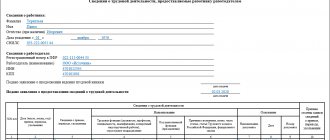What type of seal should be used for documents?
Organizations and individual entrepreneurs can use the following seal to certify documents:
- main;
- structural unit;
- special (for example, printing for documents for internal use).
The legislation of the Russian Federation does not contain any classification of seals - the use of the above varieties has developed in practice.
The need to use seals for documents other than the main one may be due to the difficulty of obtaining operational access to the main seal for structural divisions of the company or specific employees. Therefore, they may be given the opportunity to use appropriate alternative instruments for document certification.
From a legal point of view, all types of seals used by a company are equivalent if:
- through them it is possible to record on paper the full name of the company, as well as its address;
- they are round in shape;
- the name of the type of seal used (for example, “For the HR department”) does not contradict the scope of its use (that is, the HR department cannot certify documents of the sales department with its seal).
If a document is sent to a government agency, it should be certified only with the main seal. The use of special seals or seals corresponding to structural divisions by the company when interacting with partners and contractors is carried out with their consent.
In accordance with the amendments introduced by Law No. 82-FZ of April 6, 2015 to a number of federal regulations, Russian organizations are generally not obliged to use a seal in legal relations, unless otherwise expressly prescribed by certain rules of law.
ATTENTION! If your company refuses to use a seal, you have the right not to put it either on the primary document, or on declarations, or on documents required by the Federal Tax Service. We talked about the details here.
You can learn more about the specifics of the application of legal norms governing the use of seals by organizations in the article “A seal is not a mandatory attribute of the primary property.”
But if a company still uses its own seal for documents, where can it be placed, in what part of the sheet?
How to use stamps in an organization
The provisions on the procedure for using the seal, recorded in the Unified State System of Records Management (USSD), were approved by Resolution of the State Committee for Science of the Council of Ministers of the USSR dated 09/04/1973 No. 435 and recommended for use by all ministries, departments and their subordinate institutions, organizations and enterprises when improving records management. The provisions on the press recorded in the Unified State Database remain valid to this day.
The seal is affixed on authentic documents certifying the rights of officials, facts of expenditure of funds and material assets, on settlement and payment documents, certificates, powers of attorney, on organizational documents (for example: regulations, charters, constituent documents, staffing tables, etc.). A seal impression is also affixed in all cases when it is necessary to certify the rights of officials of the organization, confirming the expenditure of funds and material assets, etc.
It is important to know:
- A seal impression is placed on documents to certify their authenticity and confirm their legal force.
- Seals are produced in strictly limited quantities and exclusively for official purposes.
Which part of the document is stamped?
In most cases, a stamp is affixed to documents next to the signature of the person who certified the official paper. As a rule, the abbreviation “M.P.” is present in the corresponding area of the document. (place for printing). But if it is not provided in the original form, you should not enter it manually.
Where can I put a stamp on documents when they are certified? So, on the document being certified, the seal must be placed in such a way that it allows:
- recognize other significant details of the document (the names of the columns and the information they contain);
- certify the authenticity of the signature of the person who verified the document.
It is also desirable that the seal partially covers one of the words that makes up the job title of the person signing the document.
Contractors, tax authorities and other government agencies always welcome the clearest possible print on paper (but not bold).
Is it possible to put a stamp “for documents” on a power of attorney or on primary accounting documents and reporting, ConsultantPlus experts told. Get trial access to the system and study the explanations for free.
Is there a seal? Let's use it!
Many laws directly indicated that when making certain transactions, affixing a seal is mandatory. But since having a seal is not necessary, these laws have been adjusted. And they provided for in which cases the seal impression should be affixed only if it is available:
- the seal (if available) must be certified by the report of an industrial accident - Article 230 of the Labor Code of the Russian Federation;
- a power of attorney on behalf of the organization must be signed by its head or other authorized person and sealed with the organization’s seal (if any) - Part 5 of Art. 61 Arbitration Procedure Code of the Russian Federation;
- a power of attorney on behalf of an organization is issued signed by its head or other authorized person, sealed by the seal of this organization (if any) - Part 3 of Art. 53 Code of Civil Procedure of the Russian Federation;
- To issue a double warehouse receipt, you must use the seal (if available) of paragraph. 9 clause 1 art. 913 Civil Code of the Russian Federation;
- the audit log must be stitched, numbered and certified by the seal of a legal entity, individual entrepreneur (if any) - Part 10 of Art. 16 of the Federal Law of December 26, 2008 No. 294-FZ “On the protection of the rights of legal entities and individual entrepreneurs in the exercise of state control (supervision) and municipal control”;
- a power of attorney issued on behalf of an organization to another person must be signed by the head or another authorized person and sealed with the seal of the organization (if any) - Part 2 of Art. 54 of the Federal Law of October 2, 2007 No. 229-FZ “On Enforcement Proceedings”;
- when submitting copies of constituent documents to the registration authority, they must be certified by the seal of the legal entity (if any) - Part 9 of Art. 18 Federal Law of July 13, 2015 No. 218-FZ “On State Registration of Real Estate”;
- The release (sale) of ethyl alcohol is carried out if the purchasing organization has a copy of the notice of advance payment of excise duty certified by the signature of the head and seal (if any) with a mark of the tax authority at the place of registration of the buyer of alcohol - subclause. 5 p. 1 art. 10.2 of the Federal Law of November 22, 1995 No. 171-FZ “On state regulation of the production and turnover of ethyl alcohol, alcoholic and alcohol-containing products and on limiting the consumption (drinking) of alcoholic products”;
- statements of the securities account must be certified with a seal (if available); mortgages on the fulfillment of the obligation secured by the mortgage - para. 6 clause 1 art. 17, paragraph 2, art. 25 of the Federal Law of July 16, 1998 No. 102-FZ “On Mortgage (Pledge of Real Estate)”.
- decisions on the issue of securities must be certified by a seal (if any); certificates of issue-grade securities; decisions on the issue of Russian depositary receipts - clause 1 of Art. 17, para. 11 hours 4 tbsp. 18, paragraph 10, art. 27.5-3 of the Federal Law of April 22, 1996 No. 39-FZ “On the Securities Market”;
- the seal (if available) must be certified by documents containing information about the share of the Russian Federation, a constituent entity of the Russian Federation or a municipal entity in the authorized capital of a legal entity; documents submitted by applicants for the purchase of property - clause 6, part 3, art. 90 of the Federal Law of December 21, 2001 No. 178-FZ “On the privatization of state and municipal property” (paragraph 4, paragraph 1, paragraph 1, paragraph 2, article 16);
- a seal (if any) must be affixed to a copy of the auditor's report on the reliability of the financial statements attached to the application for inclusion in the register of authorized economic operators - Federal Law of November 27, 2010 No. 311-FZ “On Customs Regulation in the Russian Federation”;
- a seal (if any) must be affixed to powers of attorney attached to applications for participation in an open competition or closed auction; on an application for participation in a closed auction - Art. Art. 51, 88 of the Federal Law of 04/05/13 No. 44-FZ “On the contract system in the field of procurement of goods, works, services to meet state and municipal needs.”
- those organizations that have a seal must use it to maintain work books. Thus, a seal (if any) is required to be affixed on the title page when filling out the work book and when changing entries (clauses 2.2 and 2.3 of the instructions, approved by Resolution of the Ministry of Labor of Russia dated October 10, 2003 No. 69).
note
It follows from the law that if there is a seal, it must be affixed. After all, legislators did not provide that the seal is affixed “at discretion” or “at will.” This means that if an organization has a seal, then it needs to be used. And even if the company was created before the seal became optional, it is better not to rush to destroy it. It is possible that government agencies may require a seal on documents, citing the fact that such an organization must have a seal.
Results
In order to optimize document flow, Russian companies have the right to use not only the main, but also additional seals for documents. However, documents certified only by the main seal should be sent to official structures.
It is important to ensure that the structure of the main and additional seals for documents reflects the name and address of the company. All types of seals for documents used by the company to certify them, sent to external entities - counterparties, government agencies, must be round.
Where is the stamp placed on documents? It must be placed in such a way that it does not cover other significant entries present in the document.
You can get acquainted with other nuances of using printing when organizing document flow at an enterprise in the article “Is a seal placed on an invoice (nuances)”.
Sources: Law “On Amendments to Certain Legislative Acts of the Russian Federation Regarding the Abolition of the Mandatory Printing of Business Companies” dated 04/06/2015 N 82-FZ
You can find more complete information on the topic in ConsultantPlus. Free trial access to the system for 2 days.
Basic forms of prints
Since there is no formal classification, depending on the type of organization, there are four main types of typical prints :
- Simple . Includes basic information: company name, form of activity, address.
- With microtext . It has a complex edging. It runs along the edge of the print in two layers. The external one includes text in small font, most often the registration number is indicated there. Internal contains information about the enterprise itself.
- With edging . Making customized seals allows you to choose different types of design. The ornament passes between the outer and inner layers without affecting the inscription.
- For individual entrepreneurs . Contains information about the entrepreneur: full name and details.
Choosing the appearance of the seal is the responsibility of the manager. The pattern on the stamp should be concise and understandable, and the font should be clear and easy to read.
For more information on accepting goods from the supplier, paperwork and round printing, see the video below.
Using a seal impression when preparing documents
In the text of the article, the seal of an organization for non-state entities is analogous to the official seal for government organizations.
The first entry on the procedure for using the seal appeared in the Unified State System of Records Management (USSD), approved by Resolution of the State Committee for Science of the Council of Ministers of the USSR dated September 4, 1973 No. 435 and recommended for use by all ministries, departments and their subordinate institutions, organizations and enterprises when improving records management. The provisions on the press recorded in the Unified State Database remain valid to this day.
Let us consider the relevant provisions of the Unified State Data Sheet, since they most specifically and fully formulate the methodological recommendations for the use of printing that are in force to this day.
It has been established that documents that require special certification of their authenticity must be stamped. Official seal
is placed on those documents on which the reproduction of the official seal imprint is specifically provided for by regulation, for example on work books, title pages. In addition, the use of a stamp seal is necessary:
- in all cases, certification of the rights of individuals and legal entities; when establishing facts causing the receipt or expenditure of funds and material assets; on the charters, regulations of organizations and enterprises; on powers of attorney, contracts, certificates.
A seal reproducing the name of the relevant institution, without the image of the coat of arms, as well as the seals of its structural divisions (not stamped)
can be placed:
- on copies of documents sent to other institutions or handed to individuals; duplicated copies of administrative documents when distributing them; certificates confirming facts related to the work activities of citizens (place of work, salary, etc.).
The list of other documents on which the seal is affixed is determined by the institution on the basis of current regulations.
In the State Documentation Management System, approved. by order of the Main Archive of the USSR dated May 25, 1988 No. 33 / Basic provisions. General requirements for documents and documentation support services / (GSDOU) rules for using the seal are set out very sparingly: to certify the rights of officials, record the fact of spending monetary and material assets, in cases provided for by legal acts, the signature of the responsible person is certified with an official seal. The use of other seals is not indicated. But it is precisely in the State SDOU that the seal impression should be affixed in such a way that it covers part of the job title of the person signing the document.
The storage location of the seal is determined by the head of the organization.
The appendix to the GSDOU provides an approximate list of documents on which the official seal is affixed. This is a fairly extensive list, for example:
- acts of acceptance of completed construction projects, completed work, examination, etc.; contracts for supplies, contracts, rental of premises, etc.; travel certificates; samples of seal impressions and signatures of employees who have the right to carry out financial and business transactions; letters of guarantee; staffing schedules, changes to them, etc.
The rules written down by the Unified State Statistics Service and the State Budgetary Educational Institution are still included in the instructions for office work. Currently, the use of seals and stamps in the preparation of documents is regulated by a number of legislative and other regulatory legal acts, which regulate mainly the technical side of the use of seals (sizes, inscriptions, production etc.) . p.) and mainly – stamp. At the same time, such fundamental issues as:
- what seals can be used by organizations, including non-governmental ones; who has the right to order the production of a stamp or other seal and in what quantities; in what cases and on what documents they are affixed and by whom; who decides on the use of seal impressions; how practically a seal impression is located on a signed document, etc.
Current regulations allow the organization itself to regulate these operations. It should be noted that the modern regulatory framework does not address the actual problem of using a seal when using computer technology, especially when drawing up documents that ensure the rights of citizens. For the development of practical recommendations, the definition of the terms “seal and stamp” is important. , which is given, for example, in the Order of the Mayor of Moscow dated August 25, 1998 No. 843-rm.
Seal
- a matrix cut out on a solid object for making impressions of a round or triangular shape for the purpose of authenticating or attesting something.
A stamp
is a type of rectangular seal.
To streamline the use of seals and stamps in the organization, appropriate instructions
, which may include a section related to the personnel service. The instructions are approved by the first manager due to the special importance of document authentication. The instructions may have the following sections:
- procedure for placing an order for the production of seals and stamps; procedure for storing and destroying seals and stamps; procedure for using seals and stamps.
The first two sections are discussed in detail in the article by A.S. Demushkina “Seals and stamps. Protection against counterfeiting.” Therefore, further we will consider the contents of only the third section. The instructions must contain lists of documents certified by the official seal (seal of the organization); a seal without reproducing the coat of arms or other symbols; seal of the structural unit, including the personnel department. The preparation of the instructions is linked to the development of the Table of unified forms of documents used in the organization, which has a column “seal”, establishing its necessity in relation to each form of document included in the Table.
As an example, we can consider the order of the Central Bank of the Russian Federation dated January 24, 1995 No. 02-11 “On the procedure for using the official seal of the Central Bank of the Russian Federation.”
In accordance with the order, the place of storage of the official seal and the person responsible for organizing the storage and use of the seal and monitoring its correct use are established.
The basis of the order is a list of documents certified by the official seal. In particular, the following are indicated:
- characteristics, travel and other official documents of Bank of Russia employees; archival certificates, copies (extracts) of archival documents; staffing schedules of the Bank of Russia; samples of signatures for opening accounts, etc. (29 items in total).
Changes and additions may be made only at the direction of the Chairman of the Bank of Russia or a person replacing him.
When preparing a section of the instructions, you should be guided by the given order. For example, a stamp must be affixed to the front side of the travel certificate, which is a document that provides employees with a number of rights: absence from the workplace, receipt of certain amounts of money, representation of the organization, etc. In the approved form of the travel certificate (Resolution of the State Statistics Committee of Russia dated 04/06/01 No. 26 “On approval of the Unified forms of primary accounting documentation for the accounting of labor and its payment”), there is no stamp certifying the authenticity of the signature.
However, it should be borne in mind that the practice of issuing travel certificates should not change and this error in the unified form should be corrected. In the instructions for the use of seals and stamps for non-state structures, the rules for using the organization’s seal*
(*by organization we mean a non-state structure)
should be guided by the relevant rules for the official seal.
The same recommendation applies to the seals of the organization’s structural divisions.
The use of seals in the organization is permitted only to employees specially appointed by order of the manager. The right to use the official seal is granted by order of the first manager from among the employees of the documentation support service of the management or financial service.
The procedure for storing and destroying seals and stamps must comply with the requirements of GOST R 6.30-97. Seals and stamps are subject to registration in the management documentation support service and are issued to structural units to users against receipt in the registration and accounting form. In departments, seals and stamps are stored in securely locked cabinets.
The destruction of seals and stamps occurs in cases of liquidation of an organization, termination of activities as a result of a merger, accession, transformation, renaming of an organization or a separate structural unit. Destruction is carried out according to an act with a mark in the registration and accounting forms. Registration and accounting forms of seals and stamps, as well as sheets with their imprints certified by the documentation support service are included in the nomenclature of the organization’s files.
The rules for using a seal can be linked to the rules for signing documents, since only a signed document is certified with a seal. Thus, the instructions may state that the official seal (seal of the organization) can be used to certify the signatures of the general director, chairman, chief engineer, deputy general director for personnel, etc.
A seal without reproducing the State Emblem of the Russian Federation or the seal of an organization can be used to certify the signatures of the head of the personnel department, the inspector of the personnel department, the director of construction and reconstruction, etc.
The level of signing of documents is also recorded in the Table and in the instructions for using seals. Based on the available materials and the organization’s own experience, a list of the names of documents certified by the official seal (seal of the organization) and lists of names of documents for each structural unit certified by the seal of the corresponding unit are compiled. The lists establish who personally and in what cases has the right to certify the authenticity of a document’s signature.
The right to have and use a seal should be recorded in the regulations on the structural unit in the “Rights” section.
Documents certified by the official seal
Documents of the preschool educational institution service, certified by the seal of the preschool educational institution service without reproduction of the State Emblem of the Russian Federation
For example, the HR department has a round seal with the name “HR Department”.
Documents of the HR department, certified by the seal of the HR department, without reproducing the State Emblem of the Russian Federation
Approximately in this way, the issue of using seals should be resolved: which ones, on which documents, and who puts them. All information can be presented in the form of a summary table. How to use stamps
when documenting management activities is not ordered and not regulated. In practice, many stamps are used:
Refundable Operator...
notarization stamp; “K” (control); “In. No...., number of copies..., date..., time”..., “DSP (access restriction), copy...”, “Copy”; corner stamp of the organization (according to the form of the letter); facsimile of signature, etc.
Stamps formally replace handwritten or typewritten records in repetitive situations of the same type, mainly in paperwork. Stamps are essentially details that are involved in giving a document legal force and speeding up document flow.
A corner stamp is used if the organization or entrepreneur does not have printed or “electronic” forms. A corner stamp can be used for short-term correspondence, issuing current certificates, etc. In this case, a corner stamp made in accordance with the above requirements gives the document an official character. Images of state symbols in corner stamps are not allowed.
The registration stamp establishes the organization’s responsibility for the document and the start of the execution period. An access restriction stamp restricts the distribution of a document, etc.
The instructions on the use of seals and stamps should list cases of use of corner and other stamps and the positions of employees who can use them: this could be the preschool educational institution service, the personnel department, etc.
The most significant in modern conditions is the facsimile signature stamp.
It can be affixed as a signature on a document, including as a signature of a person, indicating that he has read, read, agrees, etc.
Facsimile refers to an analogue of a handwritten signature, which is understood as a personal identifier, which is a control parameter for the correctness of the compilation of the mandatory details of the document and the immutability of its content.
In accordance with Art. 160 of the Civil Code of the Russian Federation, the use of facsimile reproduction of a signature using mechanical copying means, i.e. in the form of a stamp, is allowed only if there is a corresponding regulatory act or agreement of the parties.
Accordingly, the instructions must clearly state that stamps with a facsimile reproduction of the signature of the head of the organization or his deputies are allowed, if necessary, to be used on copies of documents signed in the prescribed manner. The use of facsimiles when preparing original documents is prohibited.
Written permission to make a facsimile - a stamp with a facsimile reproduction of the signature - is given only by the head of the organization, indicating in what cases and who exactly puts the facsimile signature.
Normative base:
- Civil Code of the Russian Federation, Art. 160 Order of the Central Bank of the Russian Federation dated 01.24.95 No. 02-11 “On the procedure for applying the official seal of the Central Bank of the Russian Federation” (as of 10.27.95) Resolution of the State Statistics Committee of Russia dated 04.06.01 No. 26 “On approval of unified forms of primary accounting documentation for accounting of labor and its payment” Order of the Mayor of Moscow dated 08/25/98 No. 843-rm “On the creation of a City Register of Stamps in the Moscow Registration Chamber” (as of 01/31/01)





